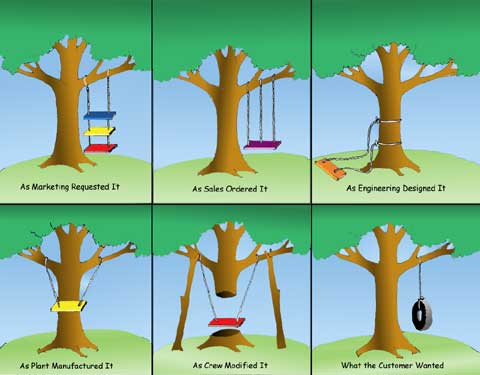
(Last Mod: 27 November 2010 21:38:40 )

Although the source of the specific illustration above is unknown, the cartoon itself has been in the public domain for decades.
Welcome to the world of engineering. But what IS the world of engineering? While it's many things, one general theme that runs throughout all engineering disciplines is that engineers are, at their core, problem solvers. People will pay you to solve their problems - that is the skill that you bring to the table. That is the value that you add to a project. The better your problem solving skills, the better you will be as an engineer - and the better you will be paid as an engineer. If you don't like to solve problems and don't love the feeling of accomplishment that comes from solving a particularly challenging problem, then you should think carefully before pursuing a career in engineering. Engineering, like any other profession, is not for everyone and if you don't love the field of engineering, the unavoidable fact is that you will be competing against people that do.
Just as in any walk of life, your ability to solve engineering problems will be largely dominated by your knowledge and skills with the tools of the trade. In most engineering disciplines, the bulk of those tools involve mathematical modeling and the various methods of analysis applied to those models.
A mathematical model is nothing more than a mathematical description of the way something behaves. The model may be extremely simple, such as the motion of an object subject only to gravitational forces with friction neglected, to extremely complex, such as the motion of that same object subject not only to gravitational forces but to wind resistance and induced lift due to the turbulence around the object.
A mathematical model should only be as complex is it needs to be to solve the problem at hand. If a simple no-friction model is adequate, then the time spent developing a more accurate model is not time well spent. There are two sayings in the field of engineering that embody this concept: "If the answer's good enough - it's good enough," and, "There comes a point in the history of every project when it is time to shoot the engineers and begin production."
This course will focus on a broad variety of the ways in which data and systems are modeled and on some of the methods used to work with those models. None of these topics will be pursued to any significant depth - in that regard this is a survey course intended to give you an awareness of the kinds of tools that are available to you. This awareness is important because you can't select the most appropriate tool for a job if you don't know that tool exists and what it is used for. As the saying goes, "If the only tool you have is a hammer, everything around you looks suspiciously like a nail." You will explore many of these tools at great length in future coursework.
To be sure, the models and methods touched on in this course are not all encompassing of those you will eventually be exposed to, but nor were they chosen at random. The other goal of this course is to build a solid foundation in your ability to program in a high level language - C in our case - and the models and methods were chosen to match the progression of programming language topics.